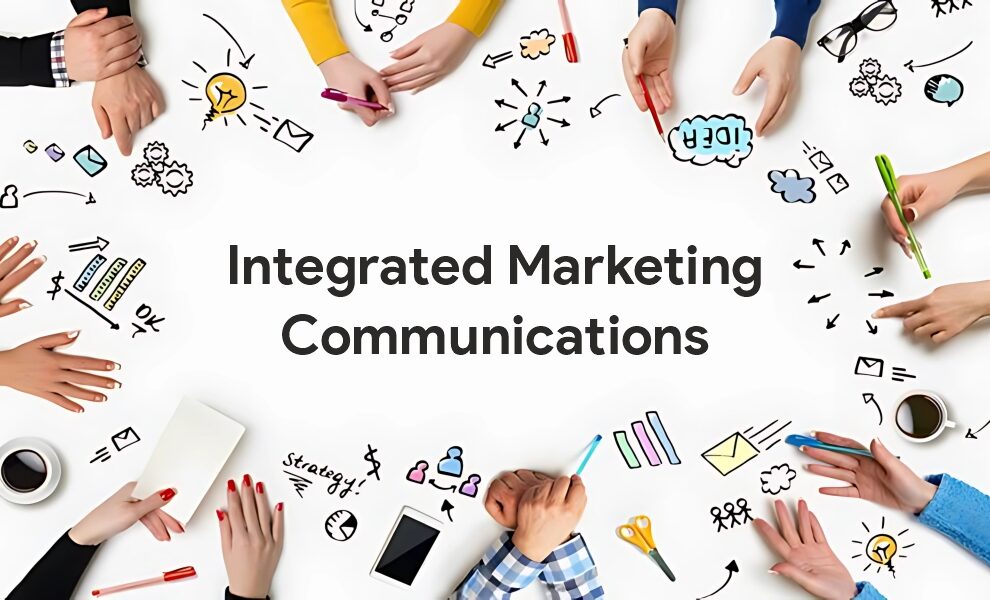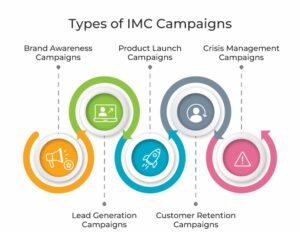Integrated marketing communications (IMC) is a strategic marketing approach that involves communicating across various channels to reach the appropriate audience for a brand. The methodology can revolve around public relations, direct marketing, advertising, sales promotions, and others, which are also known as IMC tools.
Although we can trace the inception of IMC campaigns back to the late 1980s, their usage remains an impactful strategy even now that brands worldwide prefer to integrate. Experts find that the global IMC industry size stood at $2,900 million, which is expected to surpass $6,300 million by 2031.
But how to strategize an effective IMC campaign? We have developed a thorough plan for initiating campaigns in integrated marketing communications, alongside discussing its major types, benefits, and examples. Let’s get started…
Understanding Integrated Marketing Communications (IMC)
Integrated marketing communications (IMC) involves marketing practices initiated across multiple channels to establish a unified brand experience among potential prospects. In simple terms, IMC helps brands establish strong, result-driven communication with their potential prospects, integrating multiple channels.
Such strategies offer a holistic approach that generates demand, establishes purchase intent, inspires the audience to make a purchase, fosters customer loyalty, and retains customers, ultimately establishing a strong and long-term relationship with them. Enterprises and SMBs often adopt IMC campaigns to optimize their marketing initiatives, sustaining consistency.
Advertising, public relations (PR), search, landing pages, email marketing, direct marketing, product catalogs, TV commercials, print ads, out-of-home billboards, and other channels are key components of IMC.
What is an IMC Campaign?
IMC campaigns are the planned and goal-centric initiatives for integrated marketing communication. Such campaigns are time-bound efforts that focus on IMC principles, utilizing multiple channels to boost brand awareness, enhance brand image, and strengthen customer relationships, while also doubling sales.
Types of IMC Campaigns
There are various types of integrated marketing communication campaigns, depending on the primary objective that a brand looks to fulfil, including-
- Brand Awareness Campaigns: These campaigns focus on elevating brand awareness, enabling the audience to easily recognize and recall any brand. It includes communication integrating out-of-home advertising through billboards, branding and messaging initiatives on social media, content marketing, and PR efforts.
- Lead Generation Campaigns: IMC initiatives for lead generation emphasize disseminating how a brand and its products can address the pain points of customers. Alongside that, these campaigns also aim to identify customers who genuinely have an interest in a product and are willing to make purchasing decisions.For this purpose, communication channels of email marketing, paid advertising, social media, and content marketing are utilized.
- Product Launch Campaigns: IMC approach is chiefly adopted when a brand introduces a new product or service. It helps in establishing awareness and excitement about the product among the target audience. Email marketing, social media, PR, direct marketing, and paid advertising are adopted to execute product launch campaigns.
- Customer Retention Campaigns: These campaigns are designed to build and increase the lifetime value of a product among existing customers. Here, loyalty programs such as rewards, social media interaction, and email marketing play crucial roles in establishing relationships.
- Crisis Management Campaigns: IMC strategies are implemented for risk or crisis management as well. Addressing marketing challenges and negative publicity while maintaining a positive brand reputation is easier with IMC. PR, email marketing, and social media campaigns are integrated as communication channels while managing crises.
What Benefits do Integrated Marketing Communications Offer?
Integrated marketing communications can be beneficial in several ways, boosting the marketing initiatives for companies. Let’s discuss a few-
Consistent Marketing Efforts:
The key to successful marketing initiatives is consistency and continuous efforts. IMC strategies enable brands to maintain consistency while establishing strong interaction with the target audience. This further contributes to sustainable brand awareness and recall.
Enhanced Reach:
Since IMC strategies incorporate multiple channels to build communication with the target audience, they hold the potential to reach out and target a broader audience.
Quality Communication and Engagement:
While initiating impactful two-way communication with the target audience, IMC campaigns also build strong customer relationships, driving loyalty and trust.
Stay Agile and Flexible:
IMC strategies are data-driven and feedback-oriented tactics, which allow brands to adapt to the changing dynamics of the industry. Such flexibility also enables marketers to identify and meet the evolving needs of the industry.
Discussing IMC Campaign Examples-
Apple’s ‘Shot on iPhone’ Campaign
Apple’s iPhone undoubtedly has advanced camera facilities, and to market these capabilities, the company initiated a strategic marketing campaign titled “Shot on iPhone.” The campaign focused on sharing the best photos and videos that users have taken with their iPhones.
With this campaign, Apple aimed to foster personal interaction with iPhone users by integrating user-generated content. Additionally, establishing authenticity and providing a real-time experience were key elements of this campaign. The communication channels employed are-
- Advertising– Out-of-home billboards and hoardings, TV commercials, print, and mobile ads.
- Social media outreach– Distribution of user-generated content.
Dove’s ‘Real Beauty’ Initiative
Dove’s Real Beauty campaign has been a thought-provoking initiative that tackles discrimination about female beauty and serves as a fine example of integrated marketing communication. The campaign ran for over a decade, driving sales worth more than $1.5 billion. The element of emotional connection also worked here. The channels adopted for this purpose are-
- Advertising: Out-of-home billboards, TV commercials, print, and mobile ads.
- Social media and digital marketing: Enhanced engagement across social media platforms and interactive content distribution on the website.
- On-ground initiatives: Workshops, collaborations, and Dove Self-Esteem project.
Nike’s ‘Just Do It’ Campaign
We all know ‘Just Do It’ is Nike’s brand tagline; however, it was primarily the title of the company’s cross-channel marketing campaign. Introduced in 1988, the campaign reflected remarkable results, captivating the global audience with its creative and thought-provoking approach. The marketing initiative incorporated multiple mediums, including-
- Advertising– Print and mobile ads, TV commercials.
- Social media– Augmented reality experience, posts to create hype.
- Direct marketing– Signup and promotional mails.
- Influencer outreach– Commercials featuring leading athletes.
- Sales promotions– Exclusive offers and discounts, early access to new products.
Starbucks’ Pumpkin Spice Latte Campaign
Pumpkin Spice Latte has been one of Starbucks’ iconic drinks since 2003. However, few of us know the efforts it took to market the drink, making it famous among the audience. Dedicated profiles on Instagram and X alongside popular hashtags are just a segment of Pumpkin Spice Latte’s IMC initiative. Further channels included are-
- Direct marketing– Emails and multimedia messaging service.
- Social media marketing– Dedicated accounts, giveaways, contests.
- Advertising– TV commercials, mobile and print ads.
- Sales promotions– Collaborative promotions, happy hour offers.
How to Create Plan and Execute an IMC Campaign Successfully?
Since IMC programs are a strategic initiative, they require thorough planning and appropriate execution. Below are the key stages to consider-
Step 1- Identify the target audience:
Brands must know their target audience before launching an IMC campaign. Knowing the target audience includes understanding their needs, identifying the channels through which they can be reached, and conducting behavioral analysis of the possible prospects. For this purpose, market research, intent data integration, and creating buyer personas can be handy.
Step 2- Set achievable goals:
Define objectives that you want to accomplish through an IMC program. The objectives should be relevant, specific, measurable, achievable, and time-bound. Alongside that, determine which KPIs you need to assess to measure the performance of the IMC program.
Step 3- Hire the right talent and build a team:
Create a strong team with the right talent who can execute the IMC program skillfully and help achieve the predefined goals. Establishing a high-performing team is crucial, as IMC encompasses various procedures, including content creation, graphics, social media, PR, campaign management, and others. Executing each element is important for campaign success.
Step 4- Strategize and allocate budget:
Similar to other marketing strategies, IMC also requires investments. It combines both owned media and paid media. Creating an effective team and resource management also needs a specific budget. Additionally, such tactics seek collaborations and several technological integrations. So, strategizing and allocating budget are important so that the overall budget of a company doesn’t get highly impacted.
Step 5- Choose channels and create separate content:
Given IMC’s unified strategy across multiple channels, selecting the right one is not just important; it’s essential to ensure your message reaches and resonates with the right audience. Additionally, creating content specifically for each channel is crucial.
For example, the content for email marketing, PR, and TV commercials must be tailored to match the strategic objectives and audience expectations specific to each channel.
Step 6- Prepare all the assets and schedule:
Once the content is created, all assets must be carefully prepared and scheduled. This ensures the timely execution of tasks such as airing TV commercials, installing out-of-home billboards, publishing print ads, sending emails, and others.
Step 7- Measure performance and assess results:
After executing each step, finally, brands need to measure performance and analyze the outcome of the IMC program by evaluating the key performance indicators. Measuring the outcomes will help in understanding how successful the strategy execution was.
Looking Ahead!
Over the years, integrated marketing communication has observed significant changes. Primarily, it depended on the broadcasting channels, such as billboards, hoardings, announcements on TV, radio, or newspapers. Broadcasting channels offered one-way interaction with the target audience.
However, with the evolution of technologies in recent times, IMC has enabled brands to establish two-way communication with their prospects through continuous engagement and feedback on digital platforms, such as social media. Advance your marketing efforts with integrated marketing communication and drive substantial business success.
Follow our latest blog updates to stay current with the evolving tech and marketing trends!
FAQs:
Q1. What does IMC campaign mean?
Answer: IMC or integrated marketing communication campaign means a unified marketing program that brands often undertake while initiating communication with the target audience through multiple channels.
Q2. Which is an example of an IMC campaign?
Answer: Nike’s Just Do It campaign is an example of an IMC program, which was introduced in 1988. Later, it became Nike’s brand tagline as well.
Q3. What does IMC stand for?
Answer: IMC stands for integrated marketing communications.
Q4. What are the 4 pillars of IMC?
Answer: The four pillars of integrated marketing communication are stakeholders, content, channels, and results.
Recommended For You:
AR/VR in Marketing and Advertising: The Future of Customer Engagement



